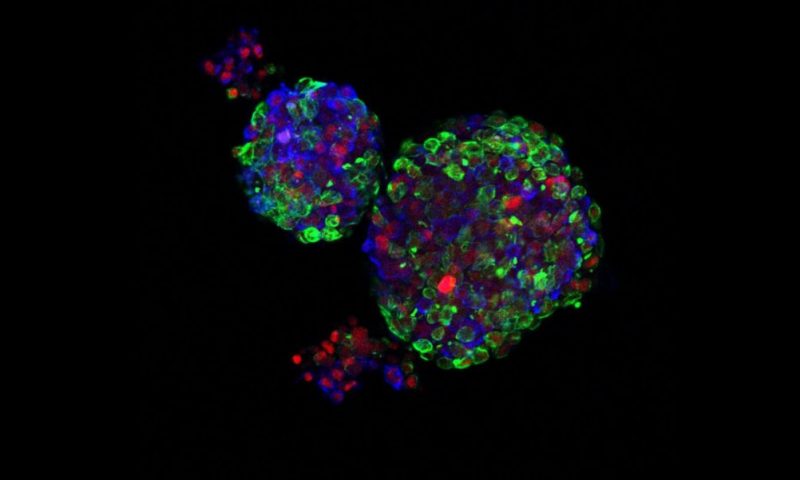Varying aspects of pregnancy have been linked to a decreased risk of developing breast cancer. Having a full-term pregnancy at an early age, an increased number of births, a history of preeclampsia, and a longer duration of breastfeeding have all been associated with a smaller risk of breast cancer. But, full explanations of the reasons why have not yet been delivered. Researchers from Cold Spring Harbor Laboratory (CSHL) have recently added another piece to the puzzle, with the discovery that pregnancy reprograms enhancer chromatin in the mammary epithelial cells (MEC) of mice and influences the transcriptional output of the oncogenic transcription factor cMYC.
The lab of Camila dos Santos, PhD, assistant professor at CSHL and senior author on the paper, is focused on understanding how the signals present during pregnancy alter gene expression, how these changes affect normal and malignant mammary development, and the molecular details that provide protective effects of pregnancy.
The findings are reported in the article, “Pregnancy reprograms the epigenome of mammary epithelial cells and blocks the development of premalignant lesions,” published in Nature Communications.
The authors write that their results “revealed epigenetic alterations to the MEC regulatory landscape that enable reactivation of pregnancy-induced programs in response to pregnancy hormones.” These programs, they noted, influenced the development of premalignant lesions in response to oncogene overexpression.
Pregnancy causes a series of cellular and molecular changes in MECs of female adults. For example, pregnancy turns off the cMYC gene—an oncogenic transcription factor. The team found, more specifically, that pregnancy “induces an expansion of the active cis-regulatory landscape of MECs, which influences the activation of pregnancy-related programs during re-exposure to pregnancy hormones in vivo and in vitro.”
“The event of pregnancy itself changes how regions of DNA are open or closed,” explained dos Santos. “Think of a yo-yo. The center of the yo-yo is what we call the nucleosome. It’s a bunch of proteins that protect the DNA. When you release a yo-yo, you have a string, which represents that part of the DNA became open. And because it’s open, now transcription factors can bind and either turn on or off genes. If you pull your yo-yo back, everything gets inside the yo-yo. That’s what we call closed chromatin, so transcription factors cannot bind there.”
Another trick the breast cells use is to stay suspended in a state of “pre-senescence,” a moment in the cell’s life cycle between dying, living, and potential cancer. The authors write that cMYC overexpression “drives post-pregnancy MECs into a senescence-like state, and perturbations of this state increase malignant phenotypic changes.”
Senescent cells “are in the gray zone, not growing or dying,” said dos Santos. Depending on how the cells are pushed, they can either stay senescent, die, or grow too much and turn into cancer cells. “It’s a very strong system, but you can mess up with it. And if you do mess up with it, that’s when cancer develops. It allows us now to work on how we can keep those senescent cells from being perturbed.”
This is one of the few examples showing that a normal developmental process such as pregnancy can inhibit a cell from interacting with a cancer-promoting gene, according to dos Santos. She summarized her key findings this way: “You have cancer genes being shut down at the same time that genes leading this cell to a kind of a precipice, like they’re going to jump out and die, get turned on. We believe these signals are the key players for why these cells do not turn into cancer.”
The team used inducible cMYC overexpression, to demonstrate that “post-pregnancy MECs are resistant to the downstream molecular programs induced by cMYC, a response that blunts carcinoma initiation, but does not perturb the normal pregnancy-induced epigenomic landscape.”
Taken together, the authors noted, their findings provide further insight into the cell-autonomous signals in post-pregnancy MECs that underpin the regulation of gene expression, cellular activation, and resistance to malignant development.
dos Santos and her team are currently working with human breast tissue organoids to see if human tissues act like those in mice. She’s also transplanting cells altered by pregnancy into mice that have never been pregnant, in order to ascertain whether the altered cells can affect a non-pregnant environment. Both experiments suggest new drug targets. “This has opened up doors for us to further explore questions that have not been explored before,” said dos Santos, such as whether puberty or aging can prevent cancer the way pregnancy does.

